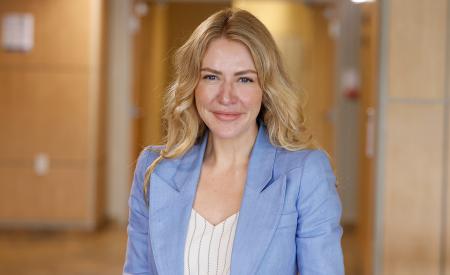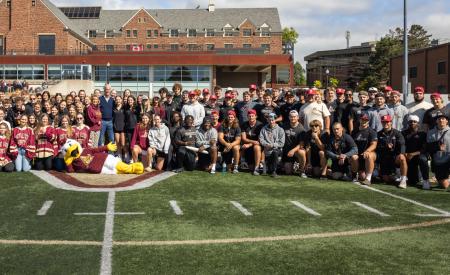Mount Allison marks 75th anniversary of residence fire that claimed four lives
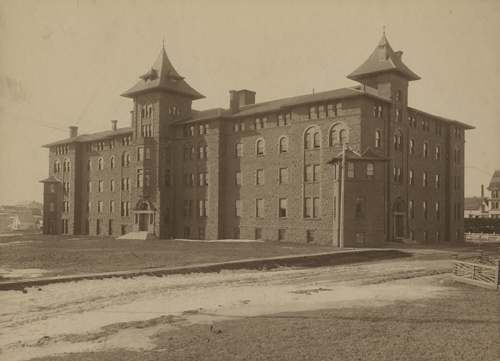
Seventy-five years on, it’s still seen as the greatest tragedy in Mount Allison’s history.
The 1941 men’s residence fire affected a generation of students.
The fire began in the bitterly cold early morning hours of Dec. 16, 1941 and completely gutted the building within a few hours.
Four students were killed. Frederick (Fred) Keillor Farrer (’44) of Saint John, NB, and Joseph (Joey) Simpson Harris Fraser (’44) of Pictou, NS, both second year students, and Melvin Mortimer Green (’45) of Sydney, NS, a first year, were lost in the fire. James (Jimmy) Creelman MacDonald (’45) of Sydney, NS, also a first year student, died of his injuries.
Built in 1901, the four-storey residence was located at the corner of Salem and York Streets, approximately where Bennett and Bigelow Houses now stand.
There were more than 200 men living in the residence at the time of the fire, including 25 members of the Royal Canadian Air Force who were training as radio technicians.
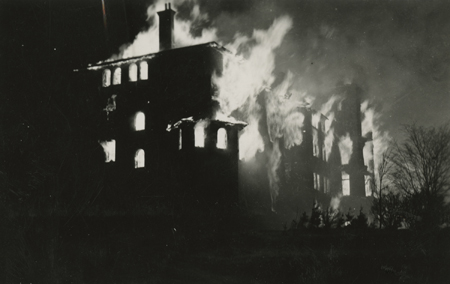
Trueman’s diary records first-hand account
Mount Allison President George Trueman writes in his diary of being woken in the middle of the night and told the residence was on fire, of coming home wet and cold at 6 a.m. He talks of the roll call at which three men were missing and how no one worried at first, then of finding two bodies in the ruins of the building and knowing the third had also died.
“The anguish and distress of the last two days is beyond expression,” he writes on Dec. 17, 1941. “What can I do when parents of these lads come, only to have their worst fears confirmed?”
Kay (Fraser) MacIntosh (’40) was teaching at the School for Girls at the time of the fire.
“My sister Eleanor and I saw Dr. Trueman, who was not young, carry more than one boy over from the burning building,” she says in a 2001 interview. “There was so little one could do.”
It was a windy night and MacIntosh says some of the young men were sent up to the roof of another University building in order to put out sparks.
“They had no equipment and all were in pyjamas, few had slippers, no coats and the temperature was below freezing and it was snowing,” she says. “Everything was in chaos.”
One of the students sent to put out sparks was Donne Smith (‘42).In a letter to his aunt dated Jan. 9, 1942, he writes, “Two Freshmen and myself stayed on one side facing the burning building and for three hours I watched the place crumble away. What thoughts were going thru my head at that time! Once someone brought up some coffee and bread. It was welcomed, but none of us were really hungry.”
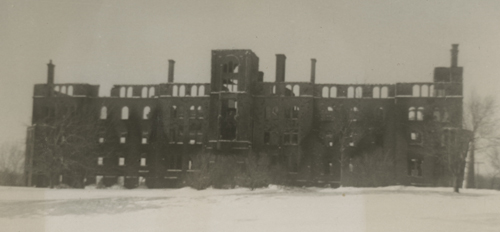
Survivors recall residence fire
A number of alumni who survived were interviewed for a Record story to mark the 60th anniversary of the fire, including Alex (’42, LLD ’68) and Rhoda Colville (’42). Alex Colville was living on the fourth floor of the residence and describes flames coming up the central staircase, “just like a huge funnel.”
Rhoda Colville was living on the top floor of the Conservatory and could see the fire from her window. Her building was evacuated to the Ladies’ College gymnasium.
“The gym floor was covered with all these students,” she recalled, describing a single candle burning at one end of the room. “People… had to walk past that and you could see their faces and Alex came with someone else and walked by and then I knew he was okay.”
Ruth (Schwartz) Goldbloom (’44) was not so lucky.
“My boyfriend at that time was Joey Fraser from New Glasgow and he was lost in the fire. I can still see his face,” she said in the 2001 interview. “The tragedy was just searing, the smoke was heavy, but the flames seared through everybody who was at Mount Allison at the time.”
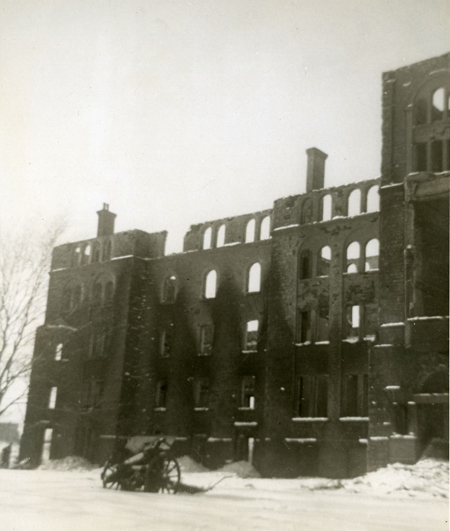
Fire spread quickly
The fire apparently started under the basement stairs shortly before 1:20 a.m. when student Allister MacLean (‘43) first spotted the flames. MacLean tried to put the fire out with an extinguisher, but was unsuccessful and turned instead to waking up fellow students.
With the stairs providing easy access, the fire spread quickly, some accounts saying the entire building was engulfed in as little as 15 minutes.
Inside, chaos was erupting. The lights went out almost immediately leaving students in darkness and heavy smoke made it even more difficult to see. The central staircase was in flames and impassable, driving students to two other staircases and the fire escapes.
“The first noise I heard was Bernie Leith running up and down the hall kicking the doors and shouting, ‘Fire!’” says Edwin (Ted) Dickie (’43) in a 2001 interview. “He was a real hero that night. You knew it was for real because you could hear the terror in Bernie’s voice.”
Leith (’43) also woke Alex Colville, saving him from the fire. Dickie went down one of the fire escapes.
“Some of the boys were hanging by their hands on the windowsills and had to let go when it got too hot,” he recalls. “I can’t remember how many broke their backs that night.”
A number of students were trapped on the fourth floor and had to make the decision to jump from the burning building. Nine students were transferred by ambulance to Amherst that evening and five were still in hospital — two in Moncton, three in Amherst — nearly three weeks later. Three had spinal fractures, one a pelvic fracture, and another severe back injuries.
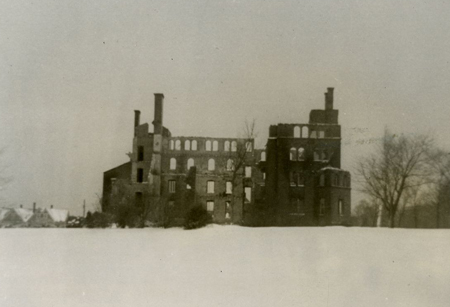
Community rallied to support survivors
In the days and weeks after the fire, students, residents of Sackville, and Mount Allison’s alumni and friends banded together to support the survivors.
The University purchased the Brunswick Hotel to house some of the displaced students and the citizens of Sackville offered 150 rooms — more than was needed — for students returning for the second term in January.
Most students lost absolutely everything in the fire — clothes, books, sports equipment. For some, this spelled an end to their university education as they did not have the funds to replace these necessities.
Rather than see that happen, the University set aside $5,000 to start a Students Assistance Fund and invited alumni and friends to contribute as well. A special April 1942 issue of the Record reported that contributions from alumni and friends totaled $15,400 at that point — the equivalent of more than $250,000 today.
Fire’s cause investigated
The cause of the fire was never determined. In the April 1942 Record, President Trueman writes, “There is little that one can say about the fire that will explain its cause. Whether the fire was accidental or of incendiary origin may never be known. It is hard for me to believe that a fire could have started of itself in any part of the building, but despite the stories current, there is up to the present no proof of incendiary origin.”
The “stories current” may have, in part, referred to the suspicions circulating around the community that the fire was set by an “enemy saboteur”. There was never any proof of this, but in December 1941 the war was headed into its third year, Pearl Harbour had been bombed the previous week, and emotions were running high.
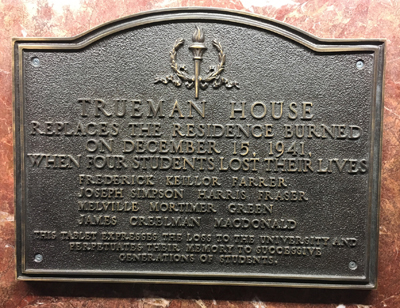
A memorial service for the four young men who died was held at Mount Allison on Feb. 1, 1942.
President Trueman spoke at the service.
“These four men of ours, whose untimely death we mourn, in their short span of life accomplished much,” he said. “It is good for us that we have known them; their memory is precious; their names will never be forgotten at Mount Allison.”
And indeed they have not been. A plaque commemorating Farrer, Fraser, Green, and MacDonald holds pride of place in the Wallace McCain Student Centre, formerly Trueman House, the residence built to replace the building lost in the fire.
Hear more on CBC News New Brunswick.



